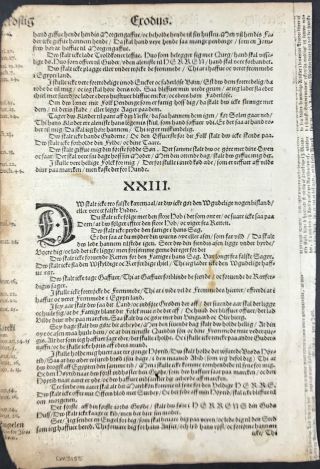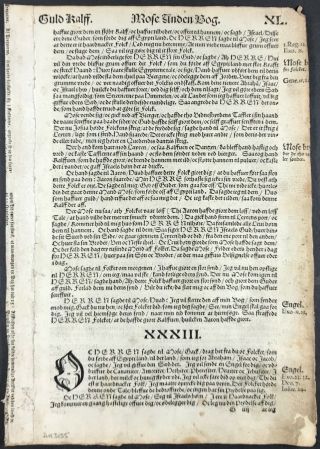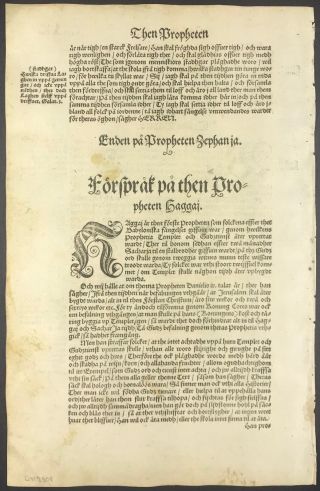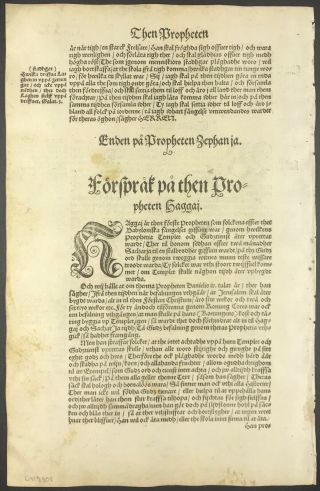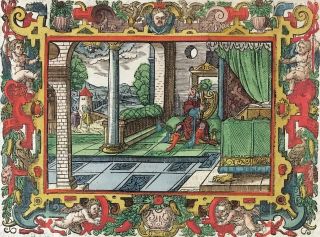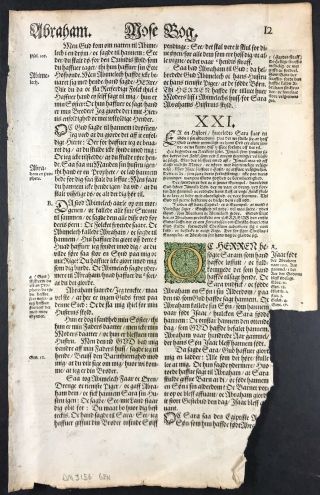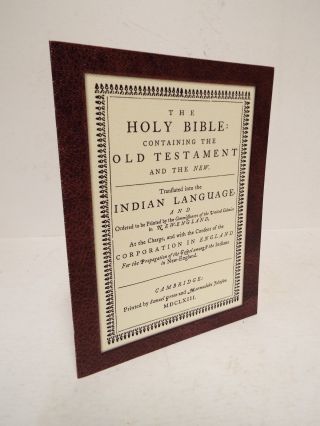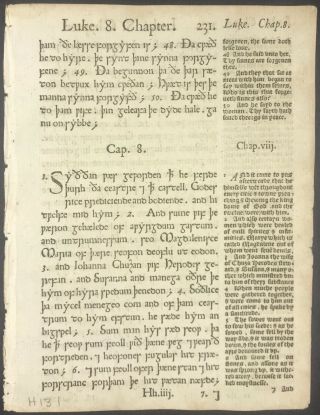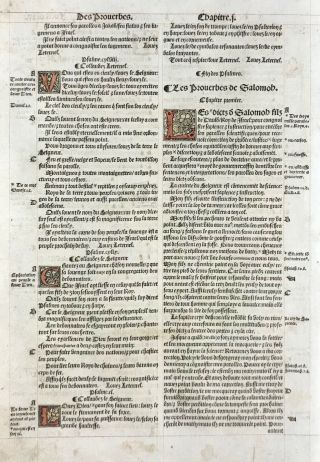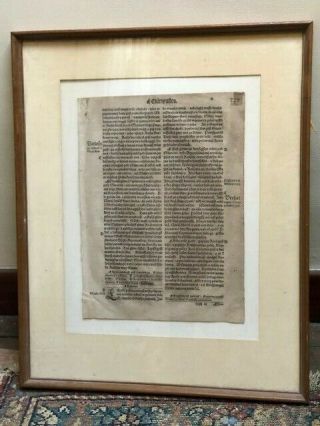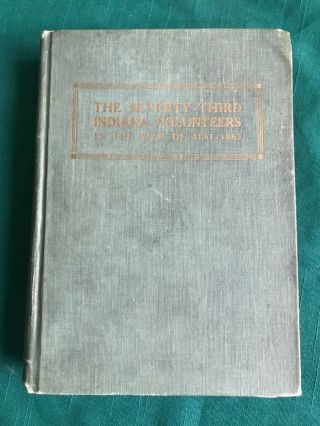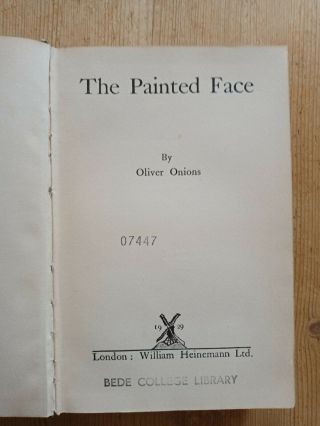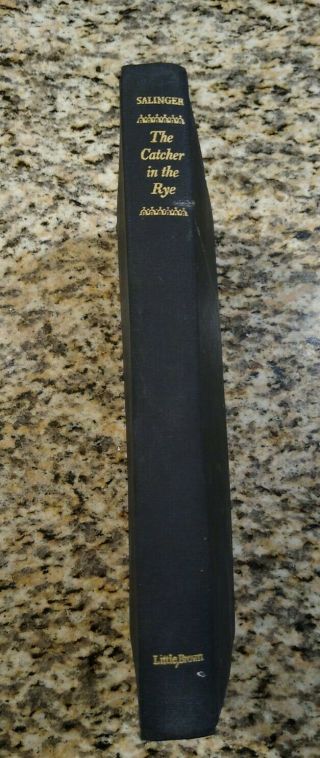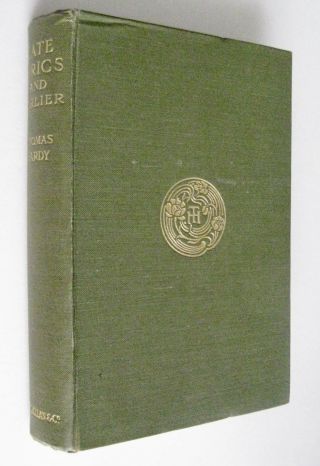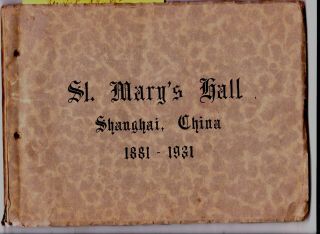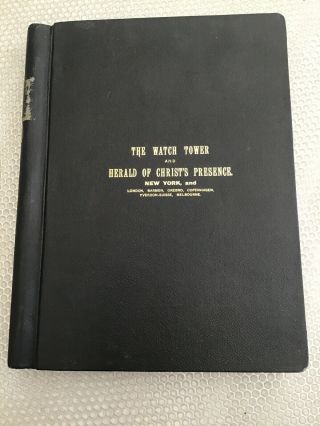Danish Genealogy - 1550 Danish Bible Leaf First Edition Exodus Christian III 2
Item History & Price
Scandinavia is made up of Sweden, Norway and Denmark. Their individual languages developed out of a common Northern Germanic language. The separation of the languages was gradual but by the t...ime of the Reformation Sweden and Denmark were clearly speaking a different language. Norwegian diverged from the Danish, once again over an extended period of time, around the 18th century finally being considered a distinct language/dialect by the beginning of the 19th century. So the early Reformation Bibles of the three Scandinavian countries are represented in just two, the Swedish and Danish translations.
This BIBLICAL ARCHIVES offer is your choice of ONE original Bible leaf from the PREMIUM LEAF LIST below, of leaves recovered from a damaged copy the first edition 1550 Danish Bible (DM3155), otherwise known as Christian III's Bible. As always a Certificate of Historicity comes with each original leaf. Measurements: approximately 12 1/4" x 8 3/4". Location 3.6a
If your ancestors lived in Scandinavia during the Protestant Reformation then it is a fact they would have heard or read the Bible for the very first time in their own language using either the 1541 Swedish Bible and/or the 1550 Danish Bible. These fragments of history from the Lutheran Church are the heirlooms of all Scandinavian descendants. Proudly display them in your home, business and/or church.
The Protestant Reformation
The cry of the Protestant Reformation 500 years ago was "sola scriptura - sola fide", "scripture alone - faith alone". That truth remains just as relevant today as it did to Martin Luther back then. In reaction to the papal bull excommunicating him from the Church in Rome he burned a copy outside the walls of Wittenberg Castle. What followed was an extraordinary set of events that has shaped the world even to this day. The greatest of these events was the fresh translation of the Bible into the German language between 1522 and 1534. This act of defiance of The Roman Catholic Church set Europe on fire and all across the continent others followed with new translations of the scriptures into the vernacular languages of the other countries. The Reformation swept across Europe like a wildfire fuelled by the breath of God. Gustav Ericsson Vasa1496-1560Vasaloppet (Swedish for 'the Vasa-race') is an annual long distance cross-country ski race held on the first Sunday of March. The 90 km (56 mi) course starts in the village of Sälen and ends in the town of Mora in northwestern Dalarna, Sweden. It is the oldest cross-country ski race in the world, as well as the one with the highest number of participants.The race was inspired by a notable journey made by King Gustav Ericsson Vasa when he was fleeing from Christian II's Army in 1520. Much of the Swedish nobility was in opposition to Christian II, king of Denmark, Sweden and Norway (the Kalmar Union). In a move to eradicate the opposition, Christian invited the Swedish aristocracy to a reconciliation party in Stockholm, only to have them, including Gustav's parents, massacred in what came to be known as the Stockhom Bloodbath. Gustav fled through Dalarna, fearing for his life if he were discovered by the king's troops. At a meeting in Mora he tried to convince the residents to raise an army and start a rebellion against King Christian. The men refused to join the rebellion, so Gustav started skiing west towards Norway to seek refuge. However, some short time later, the men in Mora changed their minds and decided they wanted to join the rebellion with Gustav as their leader. They sent out the two best skiers in the county, two brothers from Mora, Lars and Engelbrekt, to search for him and they caught up with him at Sälen and convinced him to return and lead their people. On 6 June 1523, Gustav Vasa was crowned King of Sweden, after having defeated the Danish king Christian and dissolved the Kalmar Union. Since that day, Sweden has been an independent nation.Sometime after King Gustav seized power from the Danes in 1523, Archbishop Gustav Trolle, an ally of the Danish King was exiled from Sweden. The King sent a message to Pope Clement VII requesting the acceptance of a new archbishop selected by Gustav himself: Johannes Magnus.The Pope sent back his decision demanding that the unlawful expulsion of Archbishop Trolle be rescinded, and that the archbishop be reinstated. Here Sweden's remote geographical location proved to have a marked impact – for the former Archbishop had been allied with the Danish king, or at least was considered to have been so allied in contemporary Stockholm, and to reinstate him would be close to impossible for Gustav Vasa.NOTE: It should not be forgotten that often the Roman Church sold Bishoprics to the highest bidder. We are uncertain if this is the case with Trolle but if it was the case then any proposed candidate to replace a Bishopric by Gustav Vasa would not have been in the best financial interest of The Church in Rome. The love of money is the root of all evil!The King let the Pope know the impossibility of the request, and the possible results if the Pope persisted, but – for better or worse – the Pope did persist, and refused to accept the King's suggestions of archbishops. At the time, incidentally and for different reasons, there were also four other unoccupied bishop's seats, where the King made suggestions to the Pope about candidates, but the Pope only accepted one of the candidates. Because the Pope refused to budge on the issue of Gustav Trolle, the King, influenced by Lutheran scholar Olaus Petri, in 1531 took it upon himself to appoint yet another archbishop, namely the brother of Olaus, Laurentius Petri. With this royal act, the Pope lost any influence over the Swedish Church.In the 1520s, the Petri brothers led a campaign for the introduction of Lutherism. The decade saw many events which can be seen as gradual introductions of Protestantism, for instance the marriage of Olaus Petri – a consecrated priest – and several texts published by him, advocating Lutheran dogmas. A translation of the New Testament had also been published in 1526. And a full translation of the whole Bible was published in 1540/41, called the Gustav Vasa Bible. However, knowledge of Greek and Hebrew among Swedish clergymen was not sufficient for a translation from the original sources; instead the work followed the German translation by Martin Luther published in 1534.Gustav I's breaking with the Catholic Church is virtually simultaneous with Henry VIII doing the same in England; both kings acted following a similar pattern, i.e., a prolonged confrontation with the Pope culminating with the king deciding to take his own decisions independently of Rome.
Christian III1503-1559
Christian III reigned as King of Denmark from 1534 and King of Norway from 1537 until his death in 1559. During his reign he established Lutheranism as the State Church within his realms as part of the Protestant Reformation.
Christian's mother, Anna of Brandenburg, died in 1514 when he was only ten years old. His father, the future King Fredrick I of Denmark (1471-1533), remarried four years later to Sophia of Pomerania (1498-1568).
After being crowned king in 1534 a large number of wealthy Catholic citizens rebelled against his authority sending the country into a four year civil war. During this time two men came to the Christian's rescue. Neighbouring Swedish King Gustav Vasa sent two large armies to the north of Denmark to bring the civil disobedience under control. And Johannem Bugenhagen Pomern orchestrated the establishment of the Lutheran Church in Denmark. These two men were instrumental in bringing stability to the war torn country. One brought civil obedience and the other brought a spiritual awakening.
The Apostle of the North
Johannem Bugenhagen Pomern wasn't born with the surname Pomern. Pomern is an abbreviation for Pomerania. This is where Johannem Bugenhagen was from, the Duchy of Pomerania. Remember this is the same place Christian's step-mother was from. It was Johannem closest friend Martin who humorously nicknamed him Doctor Pomeranus and it stuck. So even to this day whenever he is spoken of the Pomeranus is attached to who he is. However, he could have just as easily been given the title Denmarkanus as it was he who helped Christian introduce Lutherism into Denmark. BUT it wouldn't have sounded as funny as Pomeranus. So he is called Johannem Bugenhagen Pomernanus. What a mouthful. But we are not done yet, there's more! As an ordained minister the title Reverend was attached to his doctorate so his full title and name is The Reverend Doctor Johannem Bugenhagen Pomernanus. I'll just call him "Doc" for short if you don't mind. Doc was a multifaceted individual. He was known as a scholarly theologian, an accurate historian, a best selling author, a university lecturer, a honest politician, a church planter/reformer, a seasoned traveler, a compassionate pastor, a competent translator and in retirement he was a kind and loving caregiver. He was also a good friend to those who otherwise might have been isolated because of their stand for the truth. Maybe if you are Polish you might be related to the Doc for the Duchy of Pomerania was located in what is today modern Poland. The Duchy had close connections with Scandinavia, Denmark in particular, as well as Germany. It was 1520 when the Doc first read Martin Luther and at the beginning he was not impressed. But the more he read the more convinced he became of the need for reform. He eventually moved to Wittenberg, Germany where his humility, understanding of the scripture and deep love for God brought him to the attention of the congregation of St. Mary's Church. Soon he was asked to become their pastor and the University employed him to teach theology. Being Martin Luther's pastor the Doc was asked to officiate at his wedding. He was right at the centre of the Protestant Reformation and chances are you have never even heard of him. We often give sole credit to Martin Luther for his translation of the Bible but it was the Doc who assisted him. The Doc was even responsible for the first Low-German Bible translation of 1534 the same year of the complete Lutheran Bible in German. Church PlanterAs a church planter/reformer Doc established or reformed churches at Braunscheig (1528) Hamburg (1528/29)Lubeck (1530-32) Duchy of Pomerania (1534/35) East Frisia (1534/35) Denmark-Norway (1537) Schleswig-Holstein (1542) Brunswick-Wolfenbuttel (1543) Hildesheim (1544). That's nine churches in 16 years. He became known as the Apostle of the North. So his final name and titles are, The Reverend Doctor Johannem Bugenhagen Pomernanus, the Apostle of the North. Between churches he re-founded the University of Pomerania in 1539 making it a Reformed University based upon the model of Wittenberg University where he had previously taught. In 1539 he became Superintendent of the Lutheran Church in Saxony. And while he was in Denmark reforming the church, in 1537 he crowned Christian III as king and wrote their first Church Service Book in Danish. Incidentally, he sent an inscribed copy to Henry VIII as he did with a number of his other works. ShipwreckMeanwhile in England the authorities had their hands full as William Tyndale's 1526 English New Testaments flooded into the country. Those copies confiscated were being publicly burned at St Paul's Cross in London. An arrest warrant was issued for Tyndale and by 1528 he was on the run for his life. He fled Antwerp where he had been translating the Pentateuch (The first five books of the Bible) into English and headed to Hamburg where he had agreed to meet up with his friend Myles Coverdale. We know this bit of information due to the chronicler John Foxe in his best selling book, Acts and Monuments, 1570 (2nd edition). He wrote, "At what time Tyndale had translated the fifth book of Moses called Deuteronomy, minding to print the same at Hambrough [Hamburg], he sailed thereward [from Antwerp]: where by the way upon the coast of Holland, he suffered shipwreck, by which he lost all his books, writings and copies and so was compelled to begin all again new, to his hinderance and doubling of his labour. Thus having lost by that ship both money, his copies and time, he came in another ship to Hamborough, where at his appointment Master Coverdale tarried for him, and helped him in the translating the whole five books of Moses, from Easter [March 1529] till December, in the house of a worshipful widow, Mistress Margaret van Emmerson, Anno 1529, a great sweating sickness being the same time in the town. So having dispatched his business at Hamborough, he returned afterward to Antwerp again." What a blow! Where was God in all of this? Was having a Bible in the English language really worth the risk to life and liberty? Was the deprivation of the normal comforts of life worth all the effort and expense in producing a book that was being destroyed one volume at a time by the English authorities? All of his money gone! All of his books for translating gone!! All of his translation work on the Pentateuch lost!!! It is hard on the mind to imagine the depth of despair that must have overwhelmed the scholar as he saw his life's work washed away by angry waves. However, despite the loss he carried on and at last managed to meet up with Coverdale in Hamburg. But why Hamburg? He could have gone to Wittenberg and sought protection and support from Martin Luther. Why did he tell Coverdale to meet him in Hamburg? So where was Doc Pomperanus at this time? Go on look up above and see where the Doc was in 1528/29. I'll wait while you take a quick look. Go on! LOOK!! You can read more below after you look.Scroll down to continue....
Yep! The Doc was reforming the church in Hamburg at the time. Ah ha! That is why Tyndale asked Coverdale to meet in Hamberg because his old friend from Wittenberg was there. Tyndale had worshiped at St Mary's Church, where Doc Pomeranus was the pastor, when he was learning Hebrew at Wittenberg University in 1524. Incidentally Christian II, while in exile in Wittenberg, sponsored the translation of the first Danish New Testament which was published in Leipsig, Germany that same year.There is no doubt Tyndale wanted to take advantage of the experience of a seasoned translator as he was translating the Old Testament. So he told Coverdale to meet him in Hamberg. But all of his money, books and translating work was gone. All gone. So where did Tyndale find the means to start over? How could he have assembled a library of Hebrew texts, grammars and lexicons? The simple answer is, "Doc Pomeranus." For the Doc was at the time helping Luther translate portions of the Old Testament into German and he was working on the translation of the Bible into Low German. Tyndale borrowed the Doc's library. The loss of Tyndale's previous translation of the Pentateuch was no doubt a bitter pill to swallow but I have no doubt the second time around it was a much better translation than the first attempt. I wish I could have been there as the three translators encouraged one another in their mission of Sola Scriptura. Are you struggling in your service for God? Have you been shipwrecked by things out of your control? Does it seem like all is lost? Then maybe its time to go to Hamburg. Let God do his work in you first [not to worry shipwrecks are for our good] then pick yourself up and go do an even greater work for God than you have done before. Within months of leaving Hamburg, 1530, Tyndale's English Pentateuch was published. Only heaven will tell how much the Doc contributed to our English Bible. You can't tell the story of how we got our English Bible without some reference to The Reverend Doctor Johannem Bugenhagen Pomernanus, the Apostle of the North. In 1535 the Catholic Church burned Tyndale at the stake and Coverdale gave England it first English Bible. Two years later, 1537, John Roger's published Tyndale's Bible under the pseudonym Thomas Matthew and two years after that, 1539, Coverdale republished it as the Great Bible. When Henry VIII's daughter Mary became queen in 1553 she immediately arrested two men; John Rogers and Myles Coverdale, the Bible translators/editors. Rogers went to the stake and was burned to death in front of his family. But what about Coverdale? The King of Denmark, Christian III, asked Queen Mary to ban him from England instead of executing him. She agreed to release Coverdale if he left the country. How did the King of Denmark know Coverdale? Do you remember who crowned Christian III in 1537? Yep! It was Doc Pomeranus. WOW! God at work in every circumstance for our good and His glory. Modern Scandinavia
In 1541 Sweden and then in 1550 Denmark had their first vernacular Bibles based upon Martin Luther's German edition of 1534. It can rightly be said that these two Bibles are the foundation documents of modern Scandinavia. These new Bibles established the use of the Swedish and Danish languages as distinct one from the other and subsequently in time defined Scandinavian culture. It fixed a uniform spelling of words in both countries, particularly in Sweden the infinitive ending -a instead of the more Danish-sounding -e, and defined the use of the vowels å, ä and ö. It is from this point onwards that Sweden is Sweden and Denmark is Denmark. The Swedish and Danish Bibles are the DNA of Scandinavia.
The Tyndale Society JournalCompiled by Valerie Offord March 2001, TSJ18 SourceRaes, Peter E. På sporet af gamle bibler. Akademisk Forlag, Denmark 1995.A chance meeting with Peter Raes in a Genevan church led to my being sent his interesting book entitled På sporet af gamle bibler. Now I am fully aware that our Society members possess many linguistic talents but I suspect this particular 1995 Danish publication (On the track of old Bibles) has not been on their reading lists. Fortunately for me the author had thoughtfully incorporated a short summary of his main thesis in English. Thus it was that I discovered that early Danish Bibles, particularly the 1550 translation authorized by Christian III, helped form the Danish language. This is, of course, a very familiar argument which we have heard employed by historians and linguists when speaking of the English translation of Tyndale, the German translation of Luther, the French translation of Calvin, and so on.There had been previously successful Danish translations of the New Testament in 1524 and 1529 as well as various books of the Old Testament but what really brought fine, plain, understandable Danish out to the common man were the new church folio Bibles of 1550, 1589 and 1633. By royal decree, Christian III’s 1550 Bible, based mainly on Lutheran Bibles, was ordered to be bought by and read in every parish in the realm; very similar to Henry’s decree of 1540 in England. It took many years for this goal to be reached as the geographical area was large - Denmark’s possessions at that time included all of Norway, southern Sweden and, in practice, Iceland - and the economic burden on local parish finances was considerable. However, this Lutheran Bible translated into Danish came eventually to be widely owned and used.Production was rather slow. The whole tone, layout and illustrations of the 1550 Bible are very German; indeed the printer was Ludwig Dietz, a German from Rostock. Dietz won the contract on the strength of his having produced the 1534 Low German Bible and because, at that time, there were no printing houses in Denmark large enough to undertake the project. He brought with him not only his German compositors and apprentices but also the complicated printing equipment (presses, type and matrices). All this was essential for to print an edition comprising 3000 folio Bibles of 552 leaves each. Paper had already been ordered and delivered from Holland and had long since been in storage at Elsinore, waiting for the translation to be finished and fair copies made. Another factor in the delay was the difficulty in finalizing the business agreements.The author estimates that the number of copies still in existence is in the region of 250. He has personally traced 163 copies in the whole of Scandinavia and in the leading libraries of Northwest Europe. He remarks that nearly all of them were in poor condition and only about 15 were complete.By the 1580s this Christian III edition was out of print. Thirty-eight years later a new revised edition of the Danish church Bible was published in Copenhagen by Mads Vingaard. The king, Frederik II, wanted the text of the previous translation revised and augmented with Luther’s and Veit Dieterich’s summaries. This beautifully produced edition with numerous woodcuts, considered the greatest achievement of Danish 16th century printing, was finally completed in 1589. It is not certain how many copies were produced but probably between 2000 and 3000. After some 30-40 years of constant use in church these became very worn and the then king, Christian IV, initiat-ed the production of another Bible which was printed in 1632-33. His bishops and university professors advised him to publish a quarto edition which would have been more convenient to use and much cheaper but the king would have none of it and opted for a full folio size very similar to Frederik II’s edition.The author also discusses Icelandic Bibles. The earliest, Gudbrand’s Bible, was printed in 1584 at Hoolum in the far north of the island. This was no mean feat considering the distance from necessary materials to undertake the project - England, Denmark and the German States - as well as the primitive working conditions and lack of native expertise. Bishop Gudbrandur Thorlakson had clearly studied the Danish Christian III Bible whilst in Copenhagen and gathered enough knowledge and contacts to be able to carry out the printing in Iceland. Some 500 Bibles were printed each of 621 leaves with title pages and illustrations of German origin. A royal decree of 1579 stated that a copy was to be bought by every church on the island.This study by Peter Raes focuses our attention on the fact that vernacular Bibles were being produced during the 16th century all over Europe often drawing on the expertise and know-how of the estab-lished printing centres in England, Germany and the Low Countries.Compiled by Valerie Offord March 2001
The Offer
This BIBLICAL ARCHIVES offer is your choice of ONE original Bible leaf from the PREMIUM LEAF LIST below, of leaves recovered from a damaged copy the first edition 1550 Danish Bible (DM3155), otherwise known as Christian III's Bible. As always a Certificate of Historicity comes with each original leaf. Measurements: approximately 12 1/4" x 8 3/4". Location 3.6a
PREMIUM LEAF LIST
1. Exodus 22-23. - Folio XXXII - Photos 1-2 in the above picture gallery.
2. Exodus 33-34. - Folio XL - Photos 3-4 in the above picture gallery.
2. Exodus 35-36. - Folio XLI - Photos 5-7 in the above picture gallery.
2. Exodus 37-39. - Folio XLII - Photos 8-9 in the above picture gallery.NOTE: All interested buyers should satisfy themselves of the text reference before they BUY IT NOW. The photos of the title pages etc. do not form part of this offer. They are used for reference purposes only.ConditionTHERE IS A STORY BEHIND EVERY BLEMISH! Bible leaf collectors know that some leaves are hard to look at and others look as new as the day they left the printing press. The condition of a particular leaf reflects its history and is not an indication of its actual value. Perfect leaves are ones that have seen little or no use over the centuries in contrast to those that are scarred by the ravages of time. Unblemished leaves are unloved leaves because they have had little contact with sinners. Imperfect leaves tell a story. Some are torn and ripped and worn away by excessive use while others have burns or worm holes and still others are water stained by flood and sometimes even tears. Each ugly mark or stain is in fact a beautiful witness to the Word of God, which, "liveth and abideth forever." We offer Bible leaves as we acquire them letting their condition speak for themselves. All our leaves are sold as seen on eBay. You may request additional images and information of any leaf.




